Betzy Akersloot-Berg (1850-1922) was well known for her painting of seascapes, which was a very unusual subject for a woman in her days. During her lifetime she sold many (at least 80) of her paintings.
 Life & work
Life & work
She was born on 16 December 1850 as Betsy Rezora Berg – in Aurskog, Norway as the eldest child of five. She had three sisters (Olga, Helga and Caroline) and one brother (Bredo). Although her family belonged to the ‘better circles’, they knew financial problems and her father was unable to support her carreer financially. She followed a nursing education in Oslo, in order to be able to look after herself. During about five years she spent time as a nurse in a remote medical post/seaman’s mission in Finnmark, in order to care for the nomadic Northern people (‘Samen’). It is most likely that she developed her interest in the coast and the sea in Finnmark.
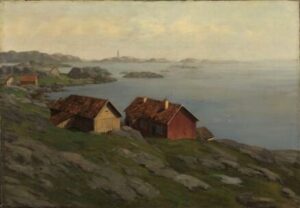 Because it was impossible for women to attend the Art Academy in those days, she followed drawing lessons at the ‘Royal Drawing School’ in Oslo. And she took private lessons with a.o. Von Hanno, Thurmann, Thaulow, Werenskiold and Otto Sinding. Sinding was most important for her as he encouraged her to paint what she wanted: coastal landscapes. Not many works from this period are kept, but this one called ‘Coastal Landscape’, painted in Helgoland, is one of them. It was made under Sinding’s influence in 1879. In order to further develop her art, she followed Sinding to München where he taught her during the winters of 1881, ’82 and 1883. During the summers she could be found on the coasts of Norway, like Lofoten, “to study my rocks and seas.”
Because it was impossible for women to attend the Art Academy in those days, she followed drawing lessons at the ‘Royal Drawing School’ in Oslo. And she took private lessons with a.o. Von Hanno, Thurmann, Thaulow, Werenskiold and Otto Sinding. Sinding was most important for her as he encouraged her to paint what she wanted: coastal landscapes. Not many works from this period are kept, but this one called ‘Coastal Landscape’, painted in Helgoland, is one of them. It was made under Sinding’s influence in 1879. In order to further develop her art, she followed Sinding to München where he taught her during the winters of 1881, ’82 and 1883. During the summers she could be found on the coasts of Norway, like Lofoten, “to study my rocks and seas.”
As from 1884 she may have been influenced by impressionism. She took part in many exhibitions like the Høstutstilling (Autumn exhibition) in 1885. In the Norwegian newspaper Aftenposten of 31 October 1885, her work is being compared to works of her male colleagues and found “of equal quality”, which she probably experienced as a great compliment as usually female painters were not valued in the public opinion.
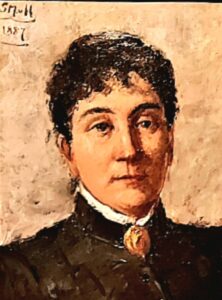
In 1885, when visiting an exhibition in Vienna, she saw the work of the Dutch sea painter Hendrik Willem Mesdag (1831-1915), which made her move to Den Haag (The Hague) in order to learn from him. He did not really take on students, but he promised to come over to her studio every now and then to comment on her work, a promise he kept. She also came to his studio in Hotel Rauch on the beach. She became quite friendly with him and his wife Sientje – who painted her portrait in 1887 (see left).
Her work from her Mesdag-years (until ca. 1888) clearly bears his influence. Her brush strokes became stronger, more lively and shows more movement. And her palet became lighter. For instance:
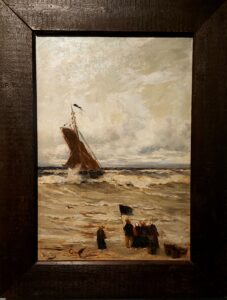
Betzy Berg
Return of a fishing boat (‘bomschuit’)
Signed lower left, dated ca. 1885-1888
Oil on canvas
Collection Museum Tromp’s Huys, Vlieland (NL).
(Photo: Ien G.M. van der Pol)
This work shows a lively composition as well as more impressionistic freshness.
She developed a great friendship with the Mesdags, (who had lost their son Kees), but when they asked to adopt her, it was time to move on and keep her ‘freedom’.
In spite of her financial problems, in the period 1890-1891 she managed to go to Paris and study with Pierre Puvis de Chavannes. Here she made some portraits and further developed her style, with firm strokes and more use of colour. It made her a well-known painter, very much in demand by exhibitions and private collectors.
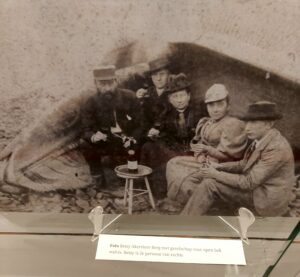 In the summer of 1892 she returned to North-Norway to paint. In the whaling station Skorøya she met Kaiser Wilhelm who ordered a painting. This might have been the reason why she embarked on board a whaler to learn about the hardships of whaling in the Northern Ice Sea. In the museum Tromp’s Huys is a photograph of her sitting with some men in front of a whale’s open jaws (see left). Brave Betzy!
In the summer of 1892 she returned to North-Norway to paint. In the whaling station Skorøya she met Kaiser Wilhelm who ordered a painting. This might have been the reason why she embarked on board a whaler to learn about the hardships of whaling in the Northern Ice Sea. In the museum Tromp’s Huys is a photograph of her sitting with some men in front of a whale’s open jaws (see left). Brave Betzy!
When she was 42, on 2 March 1893 she married Gooswinus Gerardus Akersloot, a friendly man whom she had first met at Hotel Rauch (where Mesdag had his studio for a while), and later again, possibly during a boat trip. He was a widower and seven years older than her. He must have been a broad-minded man, as he encouraged her to pursue her professional carreer and let her travel to Norway as well as many other European countries in order to study and paint, including France, Italy and England. She wanted to travel and he often came along.
In 1896, after living in several Dutch towns, the couple finally settled on the Isle of Vlieland in the North of The Netherlands. They bought an old house which, it was believed, 17th century naval hero’s De Ruyter and Tromp must have visited. Tromp was well known in Norway and Betzy named the house ‘Tromp’s Huys’. This is still the name of the museum dedicated to Betzy Akersloot-Berg.
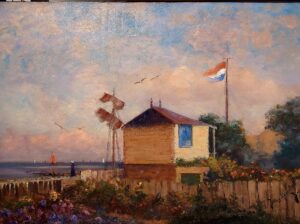 As their house was situated behind the sea dike, she had an elevated studio built, higher than the dike, directly overlooking the sea. Here she could work on her larger paintings. The building is still there.
As their house was situated behind the sea dike, she had an elevated studio built, higher than the dike, directly overlooking the sea. Here she could work on her larger paintings. The building is still there.
She made a painting of it in or after 1897 and named it ‘My studio’. On it we can also see the battered mast of the stranded ship ‘Perlen’ (1897).
She often worked on the beach of Vlieland, preferably when the weather was stormy. In order to protect herself from sweeping water and sand, she would wear an oil jacket and sit in an open chest which she had made. When she was on a ship she would sit on deck in a barrel; anything to keep on painting!
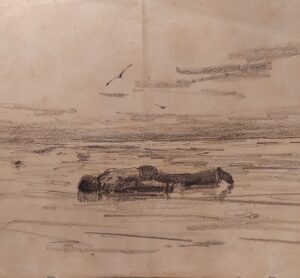 Both on the Norwegian coast as well as on Vlieland she painted many seascapes and beachviews. As said, especcially in bad weather. This is why she witnessed many shipwrecks. Once the body of a man had washed ashore and she wanted to paint the scene. But the mayor told her off and said it was ‘not done’ and ‘unrespectful’. Later she asked a man to lay in the sand in the same position, so she could still paint the drama. There is an oil painting as well as a drawing from her hand (see left).
Both on the Norwegian coast as well as on Vlieland she painted many seascapes and beachviews. As said, especcially in bad weather. This is why she witnessed many shipwrecks. Once the body of a man had washed ashore and she wanted to paint the scene. But the mayor told her off and said it was ‘not done’ and ‘unrespectful’. Later she asked a man to lay in the sand in the same position, so she could still paint the drama. There is an oil painting as well as a drawing from her hand (see left).
During the last 20 years of her life she kept on travelling to Norway and the rest of Europe as well as working at home in Vlieland. She was a hard worker and produced many coastal scenes and seascapes – both rough and peaceful – as well as some town views.
She died on 18 December 1922 at home in Vlieland – possibly of cancer of the larynx. She lies buried in the cemetery of Vlieland, underneath a simple stone, underneath her name it says: ‘sea painter’ – this is how she identified herself.
Betzy Akersloot-Berg was a remarkable, somewhat excentric personality as well as a hard working, courageous professional painter whose life & work deserve to be remembered.
Professional education
– before 1880: Royal Drawing School in Oslo; taught by Von Hanno, Capellen Thurmann &
Sinding.
– 1881-1883: taught by Otto Sinding in München.
– 1885-1888: coached by Hendrik Willem Mesdag, Den Haag.
– 1890-1891: taught by Pierre Puvis de Chavannes in Paris.
Exhibitions
Betzy Akersloot-Berg took part in many exhibitions in Belgium, Denmark, Germany, France, Netherlands, Norway, Tsech Republic and Sweden.
Much of her work can be seen in Museum Tromp’s Huys in Vlieland. Other Dutch and Norwegian museums hold works of her hand (e.g. Frans Hals Museum, Haarlem; Nasjonalgalleriet, Oslo; Rogaland Kunstmuseum, Stavanger). And many paintings are held by private collectors.
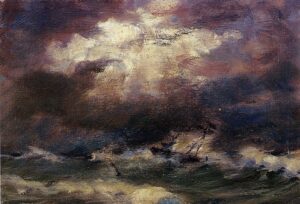 Betzy Akersloot-Berg
Betzy Akersloot-Berg
Shipwreck
oil on canvas
dated ca. 1893
24 x 32 cm.
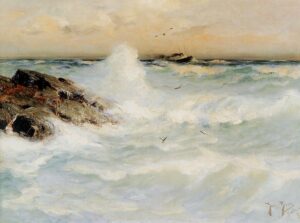 Betzy Akersloot-Berg
Betzy Akersloot-Berg
Breakers
Oil on canvas
signed lower right, d. 1888
43 x 57 cm
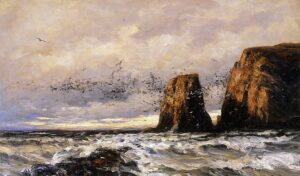 Betzy Akersloot-Berg
Betzy Akersloot-Berg
Near Gjesvaer
Oil on canvas
84 x 135 cm
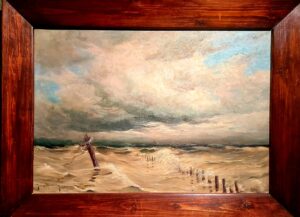 Betzy Akersloot-Berg
Betzy Akersloot-Berg
Ruwe zee
Museum Tromp’s Huys
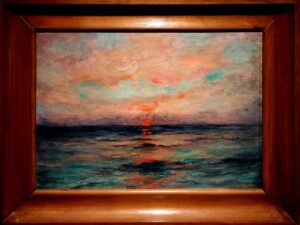 Betzy Akersloot-Berg
Betzy Akersloot-Berg
Sunset
ca. 1907
42 x 57 cm
Museum Tromp’s Huys
Sources
– Bell B. 2000, Betzy Akersloot-Berg, zeeschilderes. Franeker, uitg. Van Wijnen.
– ‘Betzy Akersloot-Berg, Vlieland’s schilderes’ in Leeuwarder Courant, 20 mei 1978.
– Hollema, C., 1979. De Noors-Nederlandse zeeschilderes Betzy Akersloot-Berg (1850-1922), geplaatst tegen de achtergrond van de algemene maatschappelijke positie van vrouwen in de schilderkunst in de 19e begin 20e eeuw, Doctoral thesis University of Amsterdam.
– Jacobs, P.M.J.E. 2000, Beeldend Benelux, vol. 1, pag. 242. Tilburg: Studiecentrum voor Beeldende Kunst.
– Museum Tromp’s Huys, Vlieland, NL, visited 23 September 2022.